Abstract: A new, simpler design for the Liahona is proposed, which, if correct, makes the reason for two spindles and a hollow-ball shape perfectly obvious. Previous proposed models of the Liahona usually show horizontal, compass-like pointers inside an open-top ball, but our model has vertical spindles protected inside a hollow ball with viewing ports to allow the aligned spindles to be superimposed on a view of the horizon, precisely marking the direction of travel. Lehi’s first use of the Liahona is discussed. Book of Mormon descriptions of the Liahona and how it was used are compared with modern attempts to visualize its design and function. A greater understanding of the Liahona’s two spindles and its surface text may yet be discovered from experimentation with physical models.
The Liahona was a ball-like instrument made of brass and specifically prepared by the hand of the Lord to direct the travel of Lehi’s extended family through the wilderness and across the ocean to a promised land. It acted somewhat like a compass. In fact, Alma explains that the word Liahona means compass:
And now, my son, I have somewhat to say concerning the thing which our fathers call a ball, or director—or our fathers called it Liahona, which is, being interpreted, a compass. (Alma 37:38)
Why, then, wasn’t the Liahona just a flat, compass-like disk with one rotating pointer to show the way? Instead, it was spherical with two internal spindles. What was the significance of having two spindles inside of a ball?
[Page 152]Book of Mormon Descriptions of the Liahona and its Function
Nephi provides a basic description of the Liahona, which was discovered by his father, Lehi, while in the valley of Lemuel. He states that it was “a round ball of curious workmanship; and it was of fine brass. And within the ball were two spindles; and the one pointed the way whither we should go into the wilderness” (1 Nephi 16:10).
The Liahona led them into the more fertile parts of the wilderness so they could hunt animals for food:
And we did follow the directions of the ball, which led us in the more fertile parts of the wilderness. And after we had traveled for the space of many days, we did pitch our tents for the space of a time, that we might again rest ourselves and obtain food for our families. And it came to pass that as I, Nephi, went forth to slay food, behold, I did break my bow, which was made of fine steel; and after I did break my bow, behold, my brethren were angry with me because of the loss of my bow, for we did obtain no food. (1 Nephi 16:16–18)
After the loss of their best hunting bow and subsequent hunting failures, which caused murmuring throughout the camp, they were startled to read messages written to them upon the surface of the Liahona. The text was written plainly for everyone to read.
And it came to pass that the voice of the Lord said unto him [Lehi]: Look upon the ball, and behold the things which are written. And it came to pass that when my father beheld the things which were written upon the ball, he did fear and tremble exceedingly, and also my brethren and the sons of Ishmael and our wives. And it came to pass that I, Nephi, beheld the pointers which were in the ball, that they did work according to the faith and diligence and heed which we did give unto them. And there was also written upon them a new writing, which was plain to be read, which did give us understanding concerning the ways of the Lord; and it was written and changed from time to time, according to the faith and diligence which we gave unto it. And thus we see that by small means the Lord can bring about great things. And it came to pass that I, Nephi, did go forth up into the top of the mountain, according to the directions which were given upon the ball. And it came to pass that I did slay wild beasts, [Page 153]insomuch that I did obtain food for our families. (1 Nephi 16:26–31)
When there was contention among them, the Liahona ceased to work:
And it came to pass that after they had bound me insomuch that I could not move, the compass, which had been prepared of the Lord, did cease to work. Wherefore, they knew not whither they should steer the ship, insomuch that there arose a great storm, yea, a great and terrible tempest, and we were driven back upon the waters for the space of three days; and they began to be frightened exceedingly lest they should be drowned in the sea; nevertheless they did not loose me. . . . And it came to pass after they had loosed me, behold, I took the compass, and it did work whither I desired it. And it came to pass that I prayed unto the Lord; and after I had prayed the winds did cease, and the storm did cease, and there was a great calm. And it came to pass that I, Nephi, did guide the ship, that we sailed again towards the promised land. (1 Nephi 18:12–13, 21–22)
After arriving in the promised land, and after Lehi’s death, Nephi’s older brothers became so jealous and angry with him that they wanted to kill him. Being forewarned, Nephi took all who would follow him and escaped into the wilderness. He had previously used the Liahona to guide his wilderness travel, so he likely used it again to lead his people through the wilderness of the promised land because he had the Liahona with him: “And I, Nephi, had also brought the records which were engraven upon the plates of brass; and also the ball, or compass, which was prepared for my father by the hand of the Lord” (2 Nephi 5:12). The place where they settled became known as the Land of Nephi.
During the centuries that followed, the Liahona, together with sacred records, was transferred from generation to generation of leaders. When wickedness among the Nephites in the Land of Nephi became intense, King Mosiah1 may have used the Liahona to guide his followers from the Land of Nephi to discover the land of Zarahemla. During their trek through the wilderness, “they were admonished continually by the word of God; and they were led by the power of his arm, through the wilderness until they came down into the land which is called the land of Zarahemla” (Omni 1:13). That description of their [Page 154]travel sounds much like the way the Liahona pointed the way and displayed sacred texts on its surfaces.
King Mosiah1’s son, King Benjamin, transferred the sacred records and the Liahona to his son, King Mosiah2:
And it came to pass that after king Benjamin had made an end of these sayings to his son [Mosiah2], that he . . . gave him . . . the plates of Nephi; and also, the sword of Laban, and the ball or director, which led our fathers through the wilderness, which was prepared by the hand of the Lord that thereby they might be led, every one according to the heed and diligence which they gave unto him. Therefore, as they were unfaithful they did not prosper nor progress in their journey, but were driven back. (Mosiah 1:15–17)
King Mosiah2 turned his kingdom over to the rule of judges and transferred the records and other sacred items to the first chief judge, Alma the younger:
And now, as I said unto you, that after king Mosiah had done these things, he took the plates of brass, and all the things which he had kept, and conferred them upon Alma, who was the son of Alma; yea, all the records, and also the interpreters, and conferred them upon him, and commanded him that he should keep and preserve them. (Mosiah 28:20)
Later, the Liahona was transferred from prophet to prophet and was considered to be a representation of the saving words of Christ, which, like the Liahona, can point to a far better land of promise:
And now, my son [Helaman], I [Alma the younger] have somewhat to say concerning the thing which our fathers call a ball, or director. . . . For just as surely as this director did bring our fathers, by following its course, to the promised land, shall the words of Christ, if we follow their course, carry us beyond this vale of sorrow into a far better land of promise. . . . The way is prepared, and if we will look we may live forever. And now, my son, see that ye take care of these sacred things, yea, see that ye look to God and live. (Alma 37:38, 45–47)
Moroni, the last of the Nephite prophets, received those sacred things, including the Liahona. In 1829, when he appeared as a heavenly messenger to Joseph Smith and the three witnesses of the Book [Page 155]of Mormon, the Liahona was among the ancient Nephite relics that he showed them.1
Eyewitnesses to the Liahona
In addition to Book of Mormon descriptions of the Liahona, four people were eyewitnesses of its existence. In June 1829, Joseph Smith, Martin Harris, David Whitmer, and Oliver Cowdery experienced a divine presentation of Nephite relics in fulfilment of a promise:
Behold, I say unto you, that you must rely upon my word, which if you do with full purpose of heart, you shall have a view of the plates, and also of the breastplate, the sword of Laban, the Urim and Thummim, which were given to the brother of Jared upon the mount, when he talked with the Lord face to face, and the miraculous directors which were given to Lehi while in the wilderness, on the borders of the Red Sea. (Doctrine and Covenants 17:1)
Of the four men, David Whitmer was the one most interviewed about what they experienced on that occasion. He consistently described the Liahona’s shape as a “ball,” but sometimes he identified it by the internal, functioning parts, such as “director,” “directors,” “ball of directors,” or “compass.”
- Interviewed by Edward Stevenson in 1877: “An angel stood before us and on the appearance of a table was laid the plates, Urim & Thummim, ball or director, sword of Laban.”2
- Interviewed by Orson Pratt in 1878: “There appeared as it were, a table with many records or plates upon it, besides the plates of the Book of Mormon, also the sword of Laban, the directors—i.e., the ball which Lehi had, and the interpreters. I saw them just as plain as I see this bed (striking the bed beside him with his hand).”3
- [Page 156]Interviewed by William H. Kelley in 1881: “A table was set before us and on it the records were placed. The records of the Nephites, from which the Book of Mormon was translated, the brass plates, the ball of directors, the sword of Laban and other plates.”4
- Interviewed by E. C. Briggs in 1884: “The angel appeared in the light, as near as that young man. [Within five or six feet.] Between us and the angel there appeared a table, and there lay upon it the sword of Laban, the ball of directors, the record, and interpreters.”5
- Interviewed by Edward Stevenson in 1886: “I . . . did see the angel standing before us, and on a table were the plates, the sword of Laban, and the ball or compass.”6
Names Given to the Liahona
Once Lehi finds the brass ball on the ground in front of his tent door, it is referred to by various descriptive names in the Book of Mormon. These names include ball, compass, Liahona, director, pointers, and those spindles. Soon after publication of the Book of Mormon, plural names such as directors, miraculous directors, and ball of directors were commonly used. Given that those names are plural, the implication is a focus on the pointing mechanism (two spindles) rather than on the ball (singular) in which they were housed. Perhaps those directors, because they were the functional part of the Liahona, became the identity of the device for some people. If so, the directors must have been easily seen inside the ball.
Speculation about the Design of the Liahona
The ancient Book of Mormon people who possessed the Liahona believed “there [could] not any man work after the manner of so curious a workmanship” when they saw the craftmanship and functions [Page 157]of the Liahona (Alma 37:39). Nevertheless, many modern people have tried to reproduce how the Liahona worked and what it looked like. Speculative models of the Liahona commonly put horizontal compass-like pointers inside an open-top ball, but they struggle to find a way to represent the function of “two spindles.” Figure 1 shows two examples, out of many, that use horizontal pointers like a modern compass.
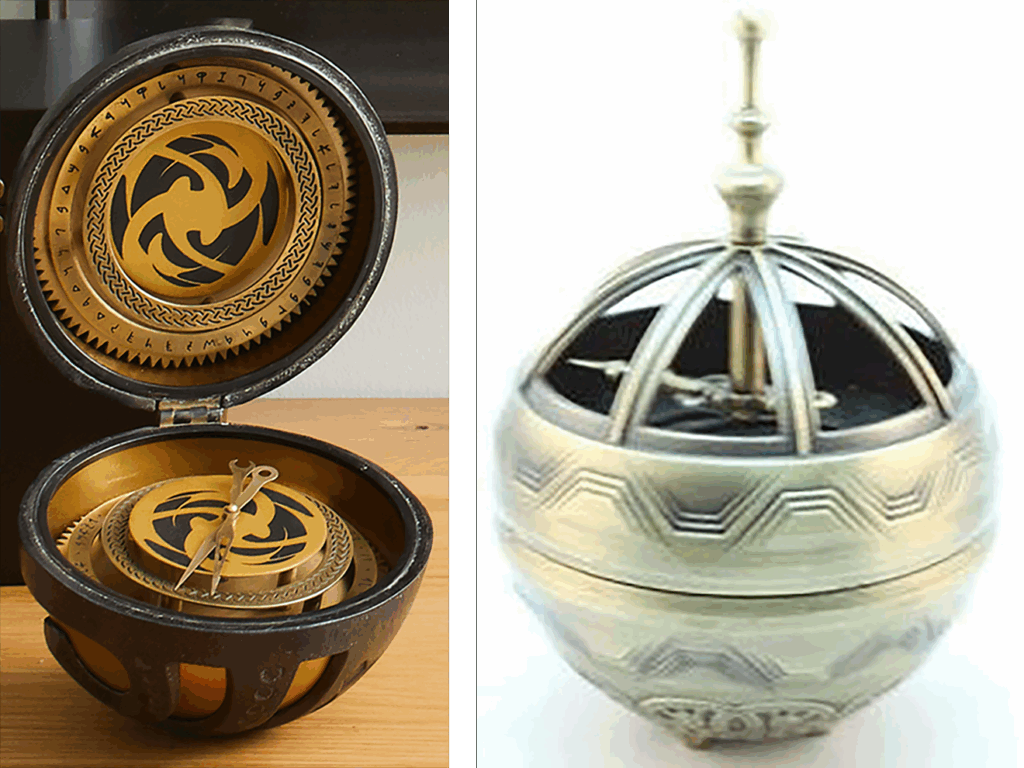
Figure 1. Left: Liahona model with ball that opens to view two horizontal pointers (Deseret Book); right: model with open top to view a horizontal pointer and a compass within (Latter Day Designs).
In 1961, Hugh Nibley acknowledged the wonderful workmanship of the Liahona’s brass ball, but he suggested that the operation of the pointers was ordinary and simple:
Moreover, while both men [Nephi and Alma] marvel at the wonderful workmanship of the brass ball in which the pointers were mounted, they refer to the operation of those pointers as “a very small thing,” so familiar to Lehi’s people that they hardly give it a second glance. So contemptuous were they of the “small means” by which “those miracles were worked” for their guidance and preservation that they [Page 158]constantly “forgot to exercise their faith” so that the compass would work. This suggests that aside from the workmanship of the mounting, there was nothing particularly strange or mystifying about the apparatus which Alma specifies as a “temporal” thing.7
In 1994, Robert Bunker observed that a single pointer or spindle would be an unreliable way of indicating direction, since it always pointed somewhere. He then innovatively suggests that two horizontal spindles could work together by both aligning in the same direction, one on top of the other, as shown in figure 2. When unified in that way it meant that the director was providing correct information. He adds that such a process would be using an engineering principle called “voting of redundant strings.” If the two spindles did not share the same alignment, it meant that the Liahona was not functioning. In his words:
This is how it would have worked: if an observer viewed the pointers and saw only a single pointer, as seen in [figure 2, left], then they were both aligned in the same direction, one on top of the other, and the director was providing correct information. Lehi’s party could then follow the indicated direction with confidence that it was the Lord’s instruction. If, on the other hand, the two pointers were cross-ways to each other—forming an “x” as shown in [figure 2, right]—then the device was not functioning, and the pointing information was not reliable. No other information was required of the Liahona, so no more than two pointers were needed. But the requirements demand a minimum of two.8
After discussing how the two spindles could have worked together, Bunker admits that “there is no engineering requirement driving the design to a sphere—a short cylinder would have been sufficient.” He surmised that the Liahona’s spherical shape “must have had additional [Page 159]symbolic meaning. Perhaps it represented the earth, more than half of whose circumference Lehi and his family would be traversing.”9
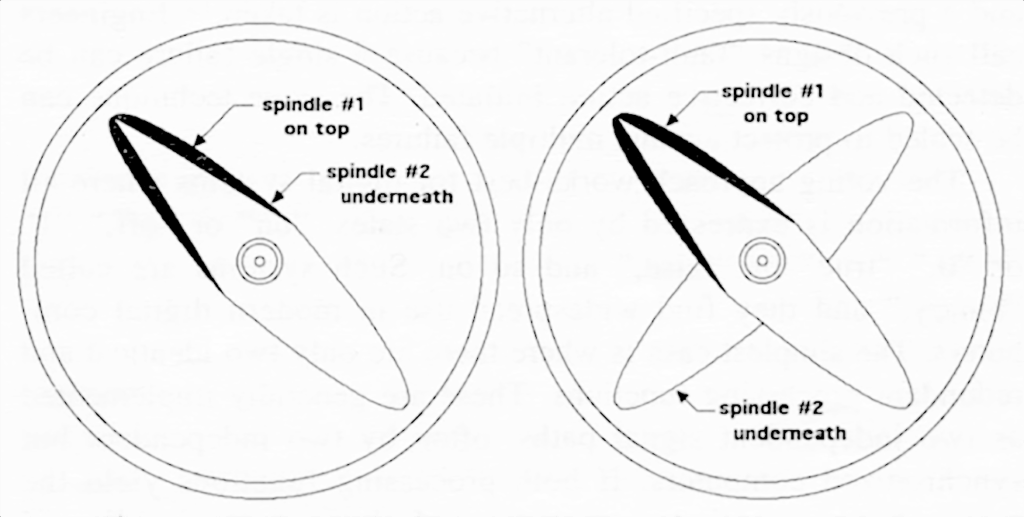
Figure 2. Bunker’s 1994 illustration of horizontal Liahona spindles. Left: “proceed as indicated”; right: “not in service.”
In 2013, Del DowDell blogged that “the second spindle on the instrument pointed to north, so that a directional finding could be determined, just as it is obvious that the first spindle pointed in the direction the Lord wanted the colony to travel.” He suggests that the north-pointing second spindle allowed Nephi to know they were traveling in a south-southeast direction.10
In 2018, Timothy Gervais and John Joyce argued that the Liahona might have been a spherical astrolabe (see an example in figure 3). Moreover, they suggest that “the Liahona may have been a wedding dowry Ishmael provided to Lehi’s family.”11 They speculate that “if the Liahona was indeed a gift from Ishmael, Ishmael would have been the primary navigator for the party until his death.”12 They reason that Ishmael was the one who knew how to use the complicated astrolabe to locate known fertile places in the Arabian wilderness, which were identified in writing on the astrolabe’s surface. The authors, therefore, tried to reconcile the Liahona to scientific law rather than to faith-based functionality. Their astrolabe proposal does not account for [Page 160]there being two spindles. Further, it is inconsistent with Nibley’s assertion that “there was nothing particularly strange or mystifying about the apparatus.”13
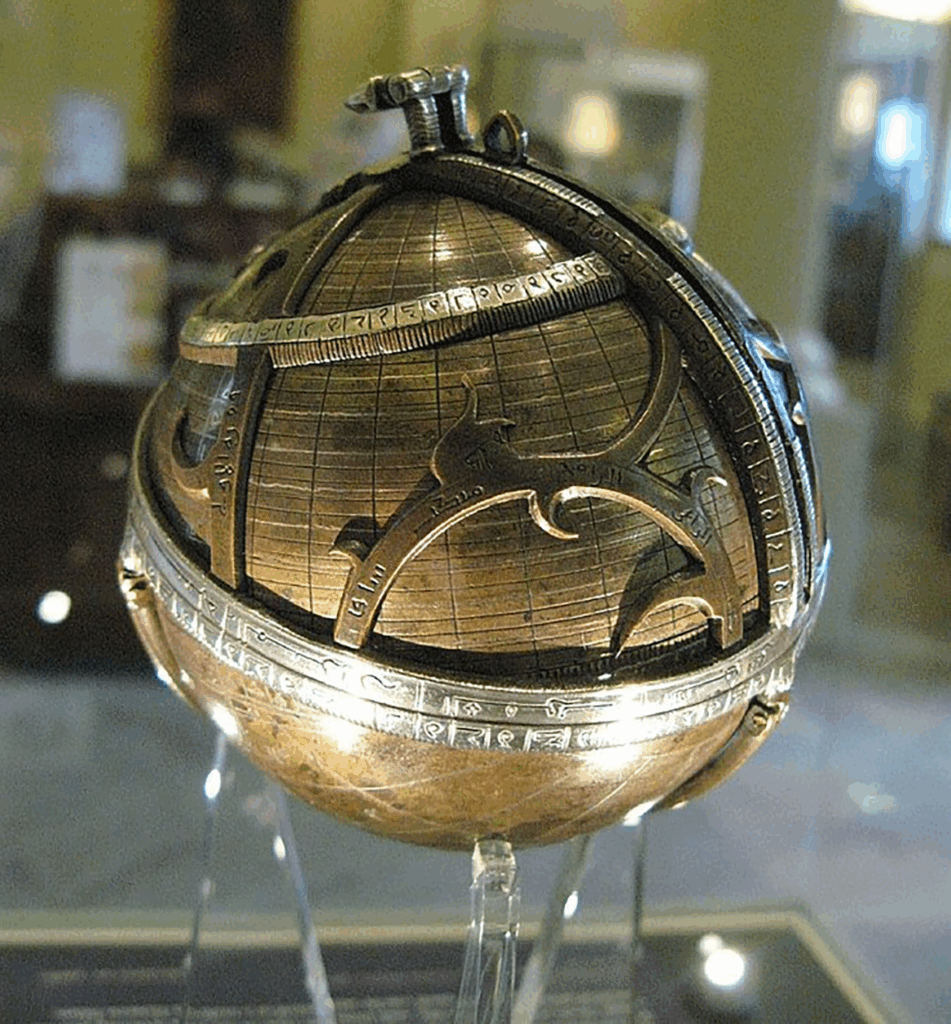
Figure 3. Spherical astrolabe from medieval Islamic astronomy, c. 1480. From the Museum of the History of Science, Oxford, UK. (Signed by Musa [CC BY 2.0], via Wikimedia Commons.)
In 2019, Don Bradley briefly explored descriptions of the Liahona given by contemporaries of Joseph Smith:
- Fayette Lapham allegedly had an interview with Joseph Smith Sr. whereby he learned about the Liahona and its function.
- Gladden Bishop allegedly received his information about the Liahona from Martin Harris (one of the three witnesses).14
[Page 161]Although Bradley does not establish the veracity of the claims made by each man, he uses their descriptions to conclude that:
While it is difficult to visualize the device precisely as Bishop intended, it is clear that on his model there were pictures around the spindles. So, while one spindle pointed a direction, the other spindle could point to a picture. . . the first spindle mandated the direction of travel; the second spindle, by pointing to one of the picture symbols around it, identified the purpose of travel. Together, the two spindles could show the Liahona’s users where to go and what they would find when they got there.15
Bradley also speculates that the Liahona was replaced by the Urim and Thummim. He writes:
While Nephi implies that he also utilized the compass . . . and handed it on to be used by his successors, by the time of Mosiah2’s reign it seems that it was no longer functioning. . . . After Mosiah1 acquired the interpreters [the Urim and Thummim]—presented as a superior instrument . . . the inferior Liahona was no longer needed and was, for the lack of better term, retired by God . . . to stand as a “token of the covenant” handed down among the Nephite kings and high priests.16
In 2021, Loren Spendlove conducted a detailed analysis of possible words and phrases in the Book of Mormon that describe the Liahona. He also provided an extensive investigation of Bradley’s sources of Lapham and Bishop. Spendlove rejected the idea that the second spindle might identify the purpose of a destination. Instead, he liked Bunker’s suggestion of two small spindles uniting to point in a single direction, especially because of the spiritual symbolism of oneness. He writes:
The Liahona, with its two spindles, presents us with an [Page 162]excellent type of this oneness and unity. If we are willing to unite, or reconcile, our will with that of God, he can lead and guide us through our spiritual wilderness (cf. 2 Nephi 10:24; 2 Nephi 33:9). Alma told us that the members of Lehi’s party “were slothful and forgot to exercise their faith and diligence. And then those marvelous works ceased, and they did not progress in their journey. Therefore they tarried in the wilderness, or did not travel a direct course” (Alma 37:41–42).17
Spendlove also notes that Alma said both spindles were needed to “point the way” (Alma 37:40). He concludes, “The two pointers, or spindles, of the Liahona were not designed to function independently.”18
In 2025, JeaNette Goates Smith wrote about the two spindles of the Liahona and how they may have worked to show Lehi’s people the correct direction for travel. In her words:
Because it had two spindles, it’s tempting to imagine the Liahona functioned like an old-fashioned watch. Like an hour hand and a second hand which, one pointed the direction generally, and the other specifically. . . . In contrast, even though the Liahona had two spindles it probably functioned more like a compass. One of the spindles always pointed the way Nephi and his family should travel. The second spindle, in my mind, could represent how close the travelers were to going in the correct direction. Their job was to align the second spindle with the first, in other words to align their direction, with the direction the Lord was pointing.19
Smith’s insight that the one [horizontal] spindle always pointed the correct way for travel and the second spindle showed “how close the travelers were to going in the correct direction” is in harmony with Bunker’s idea that both spindles needed to be “aligned in the same direction” to have confidence that the pointers showed the correct direction for travel. Smith’s concept is also in harmony with [Page 163]Spendlove’s comparison of the Liahona’s function with the need to unite our will with the will of God to receive divine guidance.
Definition of Terms
When Joseph Smith translated the Book of Mormon in 1829, Webster’s 1828 dictionary described the word “compass” as a “box” with a horizontal “needle” that pointed north.20 Two of Webster’s definitions of the word compass seem particularly significant for this discussion. Definition five reads:
An instrument for directing or ascertaining the course of ships at sea, consisting of a circular box, containing a paper card marked with the thirty two points of direction, fixed on a magnetic needle, that always points to the north, the variation excepted. The needle with the card turns on a pin in the center of the box. In the center of the needle is fixed a brass conical socket or cap, by which the card hanging on the pin turns freely round the center. The box is covered with glass, to prevent the motion of the card from being disturbed by the wind.
Figure 4 shows an example of a compass consistent with definition seven, which reads:
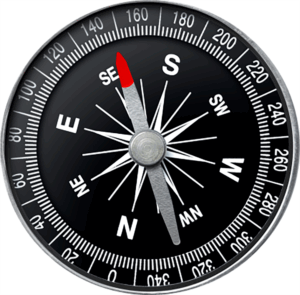
Figure 4. An example modern compass. (Microsoft Stock Image Library.)
An instrument used in surveying land, constructed in the main like the mariners compass; but with this difference, that the needle is not fitted into the card, moving with it, but plays alone; the card being drawn on the bottom of the box, and a circle divided into 360 degrees on the limb. This instrument is used in surveying land, and in directing travelers in a desert or forest, miners, etc.
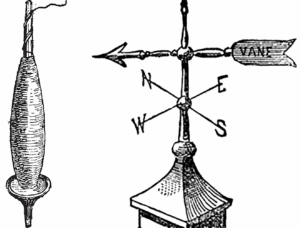
Figure 5. Left: A drop spindle for spinning thread; right: a spindle supporting a weathervane. (Shutterstock.)
In contrast to a compass, the Liahona was ball-shaped with two internal spindles that worked together to point at the direction of [Page 164]travel. Webster’s 1828 dictionary described meanings of the word spindle in Joseph Smith’s day as “the pin used in spinning wheels for twisting the thread, and on which the thread when twisted, is wound”; “a slender pointed rod or pin on which any thing turn[s]; as the spindle of a vane”; or “a long slender stalk.”21 (See figure 5.)
Our Design Concept
We agree with Hugh Nibley that there was nothing particularly strange or mystifying about the Liahona’s apparatus. We concur with Robert Bunker’s and JeaNette Smith’s idea that the two spindles needed to align with each other. We also agree with Loren Spendlove that the two spindles inside the ball did not function independently. However, we suggest that the two internal spindles were vertical, not horizontal. Using Bunker’s engineering logic, those upright spindles would drive the Liahona’s design to be a sphere instead of a short cylinder. As shown in figure 6, large openings in the ball’s shell let the user look inside the sphere to see the spindles, which were also called “pointers” or “miraculous directors.” The distant landscape could be viewed through smaller viewing ports to see where the directors pointed.22
We propose that the pointers or miraculous directors, which were protected inside the Liahona, had an axle spindle that was shaped much like the drop spindle in figure 5. One difference would be that the whorl (the disk) would have to be wider so a pointer spindle could be attached to its outer edge. The pointer spindle probably had a thicker spot on its shaft to help discern its position behind the axle spindle during the visual alignment process (see figures 7, 9, and 10). Both spindles would have been firmly attached to the whorl, which could rotate around the axle spindle. The whorl and spindles would have worked together as a unit called the pointers or the miraculous directors.
[Page 165]
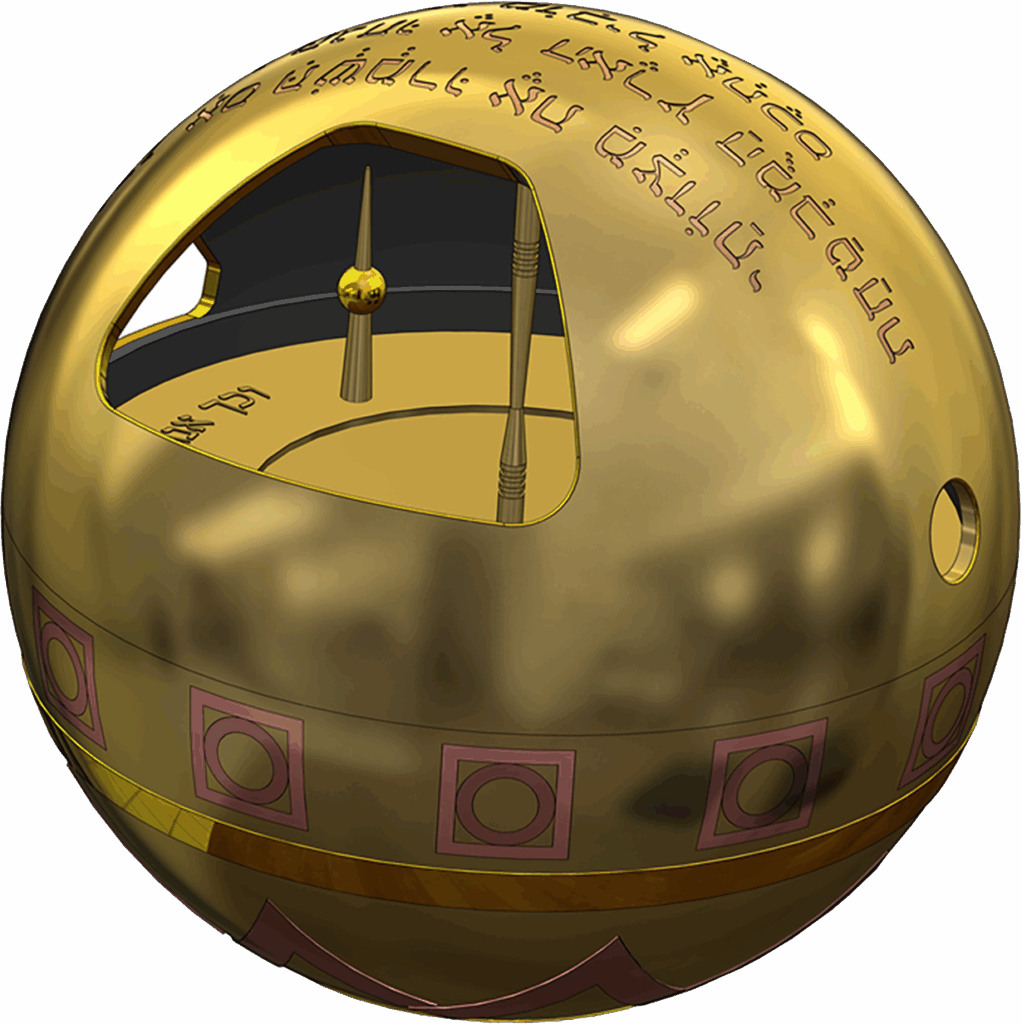
Figure 6. SolidWorks rendering of our Liahona design showing side openings used to view the “miraculous directors” (the pointers or spindles) inside the ball and smaller viewing ports in the sphere’s shell used to sight on the landscape ahead. Patterns on the ball’s surface are artistic speculation. (Image by Kyle Kinghorn.)
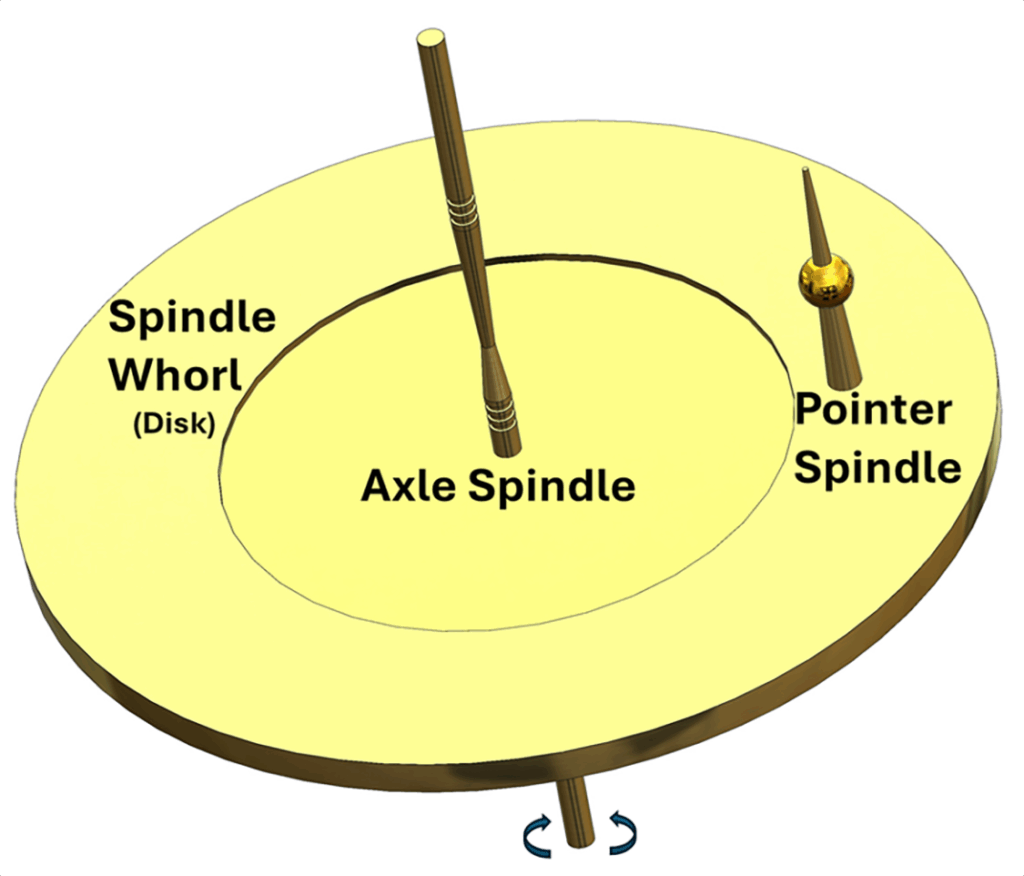
Figure 7. The “pointers” inside the Liahona. This whole pointing mechanism was sometimes called the “miraculous directors,” which consisted of an axle spindle fixed in the center of a wide whorl (disk) and a distinctive pointer spindle attached to the outer edge of the whorl. The spindle whorl and pointer spindle could rotate around the axle spindle. (Image by Kyle Kinghorn.)
[Page 166]How Did the Liahona Work?
In our proposed Liahona design, the hollow ball protects the internal pointers or miraculous directors, which consist of two vertical spindles fixed into a rotating disk (the whorl). Viewing ports in the shell of the ball let the user superimpose the aligned spindle shafts on the landscape ahead.
Although the miraculous directors behaved something like a compass needle, the Liahona was not self-operating like a magnetic compass. Nibley said the Book of Mormon makes it perfectly clear that the Liahona was also “not a magic thing, but [it] worked only by the power of God and only for appointed persons who had faith in that power.”23 Alma explained that if its authorized users “had faith to believe that God could cause that those spindles should point the way they should go, behold, it was done” (Alma 37:40).
When God set the orientation of the directors, they would not rotate around the axle spindle anymore, but remain fixed in space, pointing in the direction God wanted Lehi to travel, much like a magnetic compass needle stays in line with earth’s magnetic field to point north. We propose that the outer shell of the Liahona and its viewing ports could freely rotate around the stationary directors much like a compass case can freely rotate around a magnetic compass needle. The user could then hold the ball up to an eye, peer through the viewing-port holes, and turn the shell of the ball and himself about until the opposite viewing port was near the pointer spindle. Then, when the pointer spindle was perfectly aligned behind the axle spindle, the two vertical spindles would be superimposed on the view of the landscape ahead, pointing like gunsights at the direction they should travel (see figure 10).
Lehi and his caravan obviously did not travel in a perfectly straight line, but they followed the most prudent path toward the spot in the landscape ahead to which the directors in the Liahona had aimed them. When the next segment of their travel required a change in direction, God would move the pointer spindle to lock onto the new direction for travel, which would cause the spindle alignment to be superimposed on a new spot in the landscape ahead.
But the Liahona worked only when its users were worthy of God’s intercession, and it stopped working at times of turmoil and contention. This is pointed out in two scriptural passages:
- [Page 167]And it came to pass that I, Nephi, beheld the pointers which were in the ball, that they did work according to the faith and diligence and heed which we did give unto them. (1 Nephi 16:28)
- And it came to pass that after they had bound me insomuch that I could not move, the compass, which had been prepared of the Lord, did cease to work. (1 Nephi 18:12)
When the Liahona stopped working, the pointer spindle could have circled aimlessly without stopping to mark a directional orientation. Functional failure could also have been indicated if the pointer spindle became locked in place inside the ball, so it turned wherever the ball turned.
Lehi’s First Use of the Liahona
Lehi was surprised to see the Liahona resting on the ground in front of his tent door in the morning after being commanded to break camp and begin his family’s trek toward the promised land. His tent was on the north side of the valley (1 Nephi 16:12–13), so the tent door probably faced south. Before him there would have been a green oasis, irrigated by the River Laman, with the valley of Lemuel mountains on the other side of the oasis (see figure 8).
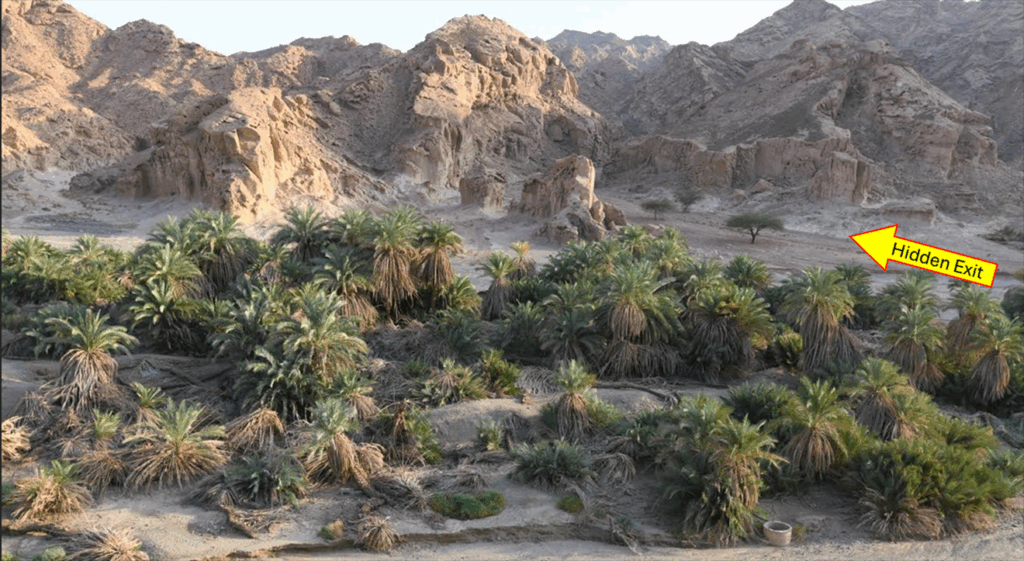
Figure 8. Valley of Lemuel, looking south from Lehi’s tent site, across the oasis of Tayyib al-Ism, with an arrow pointing toward the only southward exit from the valley. (Image courtesy of Warren P. Aston.)
The most plausible place in Arabia for Lehi’s ancient encampment in the “valley of Lemuel” is at a small oasis of date palms in a valley known today as Wadi Tayyib al-Ism. It has a deep canyon with perennial flowing water that empties into the Red Sea, which is to the west about two miles away. Because of the uniqueness of the circumstances, the actual location of Lehi’s campground has been proposed by onsite explorers and from Google Earth satellite images.24
We can imagine Lehi picking up the Liahona for the first time. He would have noticed the two vertical spindles inside the hollow ball and how they remained fixed in their orientation whether he turned the Liahona left or right. When looking directly across the valley through the viewing ports of the Liahona, the two vertical spindles were not aligned (see figure 9), but when he turned the view to the right, the spindles came into alignment, pointing at a hidden southward exit from the valley (see figure 10).
[Page 168]The aligned spindles “pointed the way whither [Lehi’s caravan] should go into the wilderness” (1 Nephi 16:10). It directed them toward an inconspicuous passageway in the mountains south of the valley of Lemuel. When Lehi’s family left their oasis campground, they said, “We did take our tents and depart into the wilderness, across the river Laman” (1 Nephi 16:12). At first glance, that wilderness exit appeared to go just a short distance up into the mountains, but it turned out to be a hidden wadi (dry riverbed), which turned eastward behind the valley mountains before continuing upward through the mountains toward the southeast (see figure 11). That easy-to-overlook mountain pass was discovered by Warren Aston during his visit to Wadi Tayyib al-Ism in 2019.25
Whenever the traveling group encountered a fork in the trail, the directors inside the Liahona could be consulted to decide which way to go. As long as they gave faithful heed to the Liahona, that kind of divine guidance continued to direct their travel through the wilderness of Arabia and eventually across the ocean to a promised land in the Americas. At sea, it could have been attached to the ship so that the viewing ports were aligned with the keel, which would be the direction [Page 170]of travel. Steering to keep the two vertical spindles aligned would keep the ship moving on its proper course toward the Promised Land.
[Page 169]
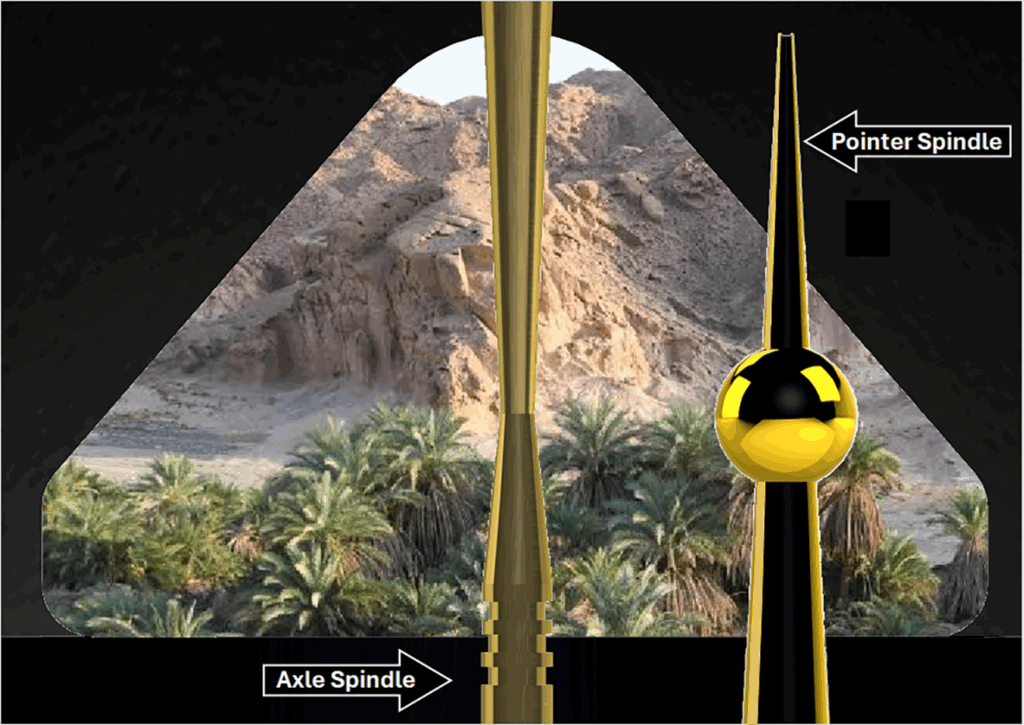
Figure 9. View through the Liahona from Lehi’s tent site looking straight across the valley of Lemuel. Because the pointer spindle is off to the right, the viewing ports are not in alignment with the two spindles, so straight ahead is not the proper direction for travel. (Image by Wanless Southwick.)
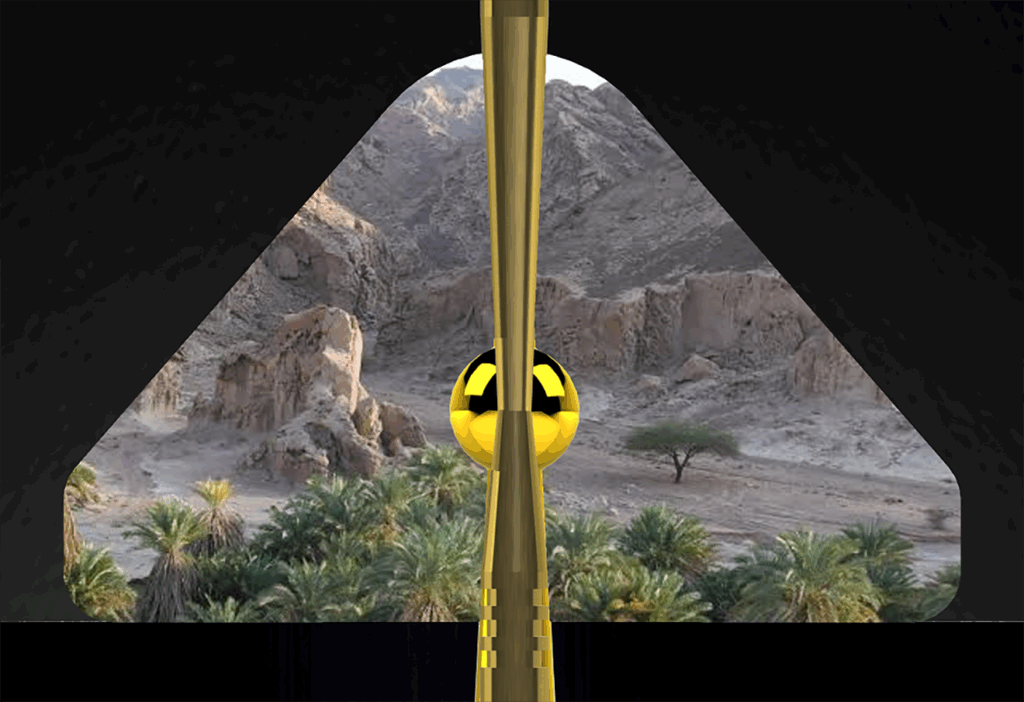
Figure 10. View through the Liahona from Lehi’s tent site after turning the Liahona’s outer shell to the right until the two spindles align like gunsights in the viewing port. The aligned spindles are superimposed on an inconspicuous southward exit from the valley of Lemuel, marking the direction for travel. (Image by Wanless Southwick.)
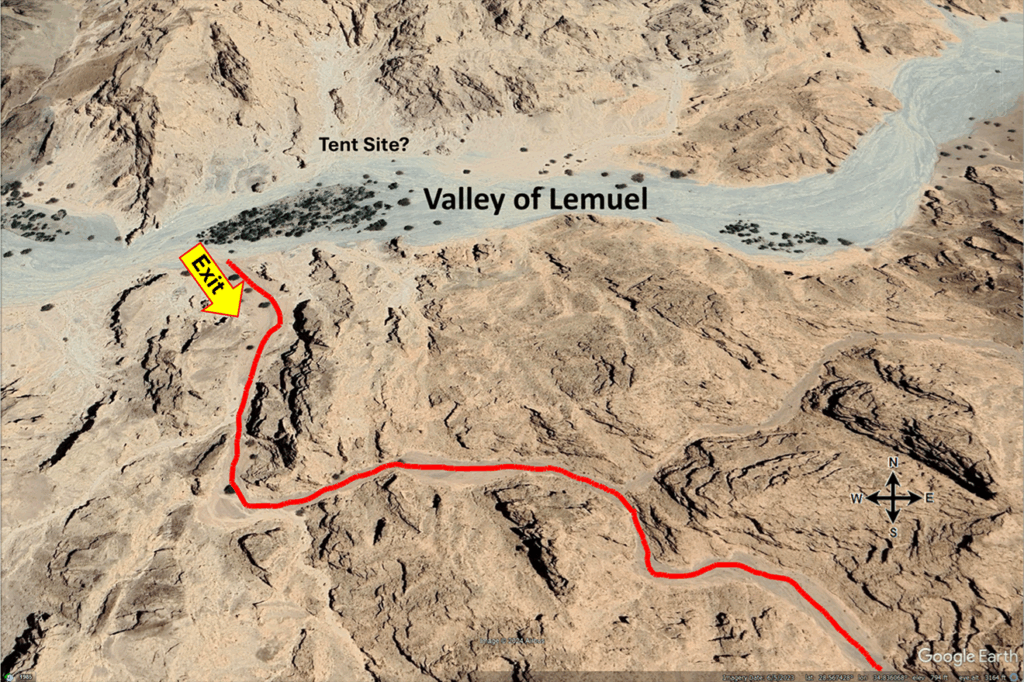
Figure 11. Lehi likely exited the valley of Lemuel by following the Liahona’s directions into an inconspicuous mountain pass. (Google Earth.)
Text on the Liahona’s Surfaces
In addition to pointing out the direction they should travel, the Liahona also displayed text on its surfaces. For example, at the time of the broken bow crisis, words appeared on the Liahona:
And it came to pass that the voice of the Lord said unto him [Lehi]: Look upon the ball, and behold the things which are written. And it came to pass that when my father beheld the things which were written upon the ball, he did fear and tremble exceedingly, and also my brethren and the sons of Ishmael and our wives. And it came to pass that I, Nephi, beheld the pointers which were in the ball, that they did work according to the faith and diligence and heed which we did give unto them. And there was also written upon them a new writing, which was plain to be read, which did give us understanding concerning the ways of the Lord; and it was written and changed from time to time, according to the faith and diligence which we gave unto it. And thus we see that by [Page 171]small means the Lord can bring about great things. (1 Nephi 16:26–29)
It is easy to visualize text being written on the ball’s outer surface because there is plenty of space there. It would be something like God writing on tablets of stone for Moses (Exodus 31:18) or God writing a message to King Belshazzar on the palace wall (Daniel 5:22–28). However, 1 Nephi 16:28–29 implies that writing also appeared on the pointers. That is how Nibley interpreted those verses when he said, “The working parts of the device were two spindles or pointers. On these a special writing would appear from time to time, clarifying and amplifying the message of the pointers.”26
Bunker struggled to explain how two horizontal pointers could have had writing upon them:
The amount of text inscribed on the pointers cannot be ascertained from Nephi’s description, but the physical size of the writing must have been small; otherwise, the observation that it “was plain to be read” (1 Nephi 16:29) would have been unnecessary. Assuming the Liahona was about five inches in diameter, then the [horizontal] pointers were about the size of a finger in length and width, thus providing a modest area for text of a few square inches.27
By contrast, the working parts in our design for the Liahona were the whorl and its vertical spindles. Together they were the pointers or miraculous directors, which both guided the travel direction of Lehi’s caravan and gave them written details to enhance understanding. The circular whorl would have provided plenty of space for the “plain-to-be-read” text. The text could have been written on the outside surface of the ball,28 on the internal pointing mechanism,29 or in both places. In figure 12, we used modern Hebrew to simulate writing that Lehi and his extended family may have seen on the Liahona (1 Nephi 16:27).
[Page 172]
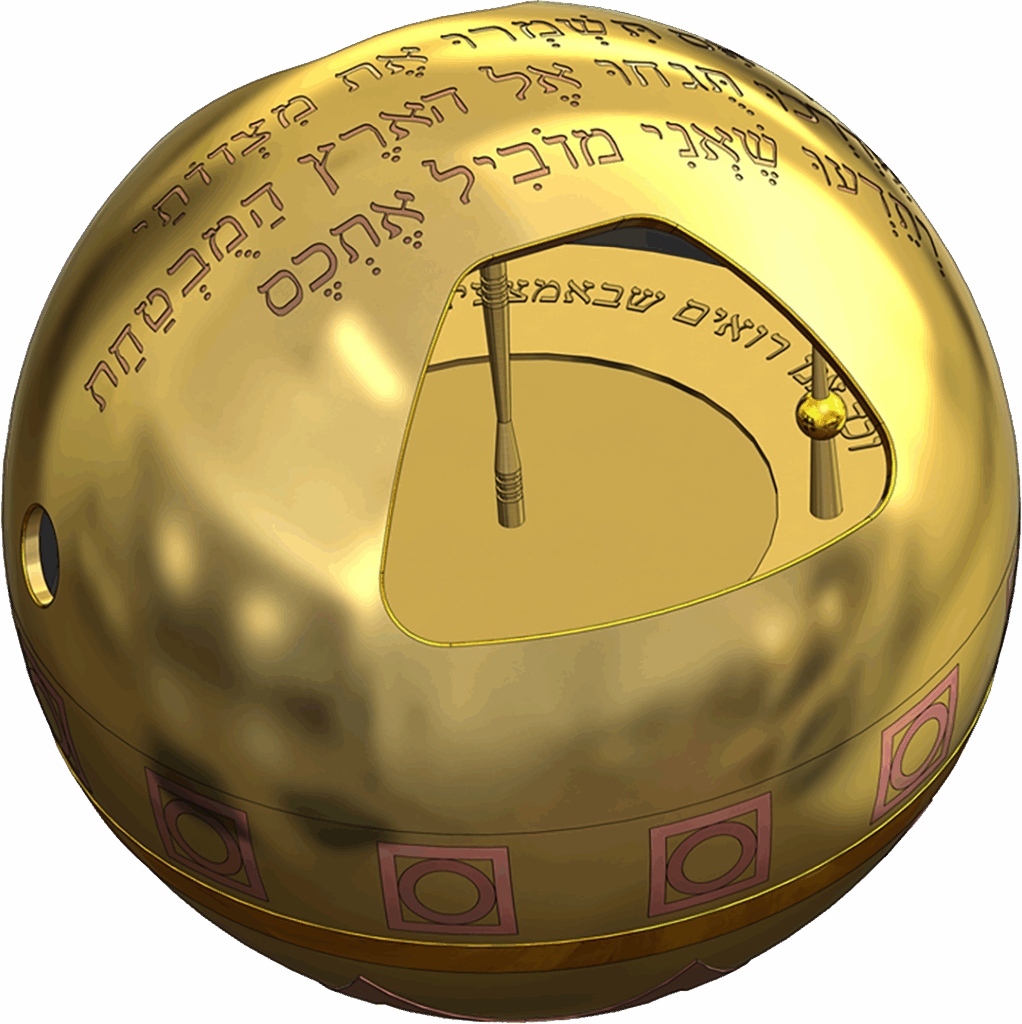
Figure 12. Model of Liahona showing how text could be written on both the outer surface of the ball and on the whorl of the pointers, also known as the miraculous directors. (Image by Kyle Kinghorn.)
Summary and Conclusions
The reason that the Liahona was a sphere and not a flat compass-like instrument was possibly because it had two vertical spindles. Those upright spindles would have needed vertical space inside the Liahona plus protection against physical damage. Sometimes the Liahona’s pointing mechanism was called the “miraculous directors,” which we suggest consisted of the two vertical spindles attached to a circular whorl. Under divine influence, the two vertical spindles (“pointers” or “directors”) aligned themselves with the direction Lehi should travel. They would have remained fixed in that alignment whether the user turned the outer shell of the Liahona to the left or to the right. When the Liahona’s viewing ports were aligned with the two vertical spindles, the spindle shafts would be superimposed, one behind the other, on a view of the landscape ahead, thus pointing like gunsights at the proper direction for travel. Further experimentation with physical models of this proposal may yet teach us more about the Liahona’s functions.
[Page 173]
Appendix
If the original Liahona were available for us to inspect, we wouldn’t need to speculate about what the two spindles looked like or guess where writing would appear on the ball; we would be able to observe it for ourselves. Book of Mormon descriptions of the Liahona would then make perfect sense and our misconceptions would evaporate. There are two additional ways to gain insight into the form and function of the ancient Liahona—working models and artwork.
Possible working model
Research for this paper proved the value of having a 3-D printed, physical model to experience how the internal miraculous directors (Doctrine and Covenants 17:1) worked independently within the outer shell of the Liahona (see figure 13). Functional educational models of this vertical-spindle Liahona could be manufactured. The circular orientation of the miraculous directors could be controlled by electronic components in the bottom hemisphere, including a small stepping motor geared to the axle spindle, which would respond to the horizontal rotation of the hollow ball as detected by electronic gyroscopes. [Page 174]Instead of having the aimed-direction be under divine control, the angular setting of the pointer spindle could be determined by a button-push to retrieve a random number (1–360 degrees) from an electronic table.
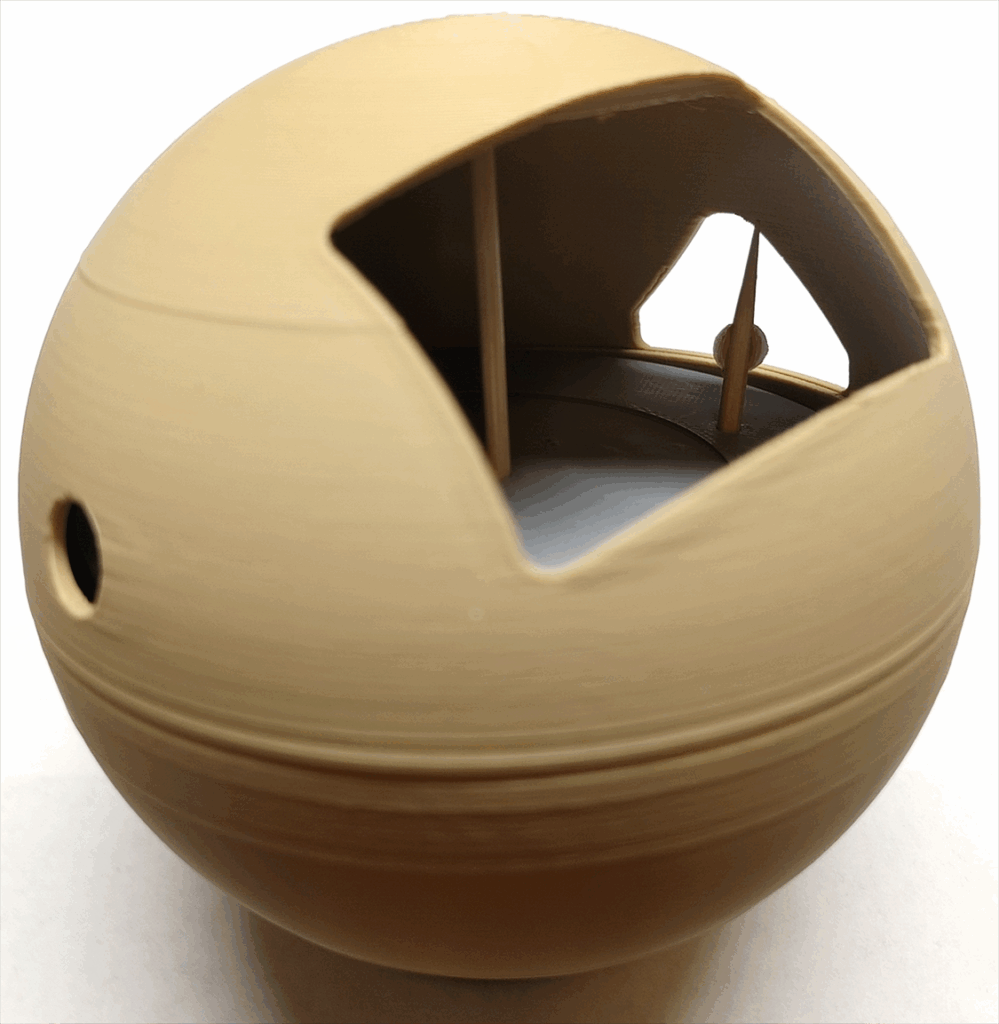
Figure 13. 3-D printed model of the Liahona used during research for this paper. (printed by Kyle Kinghorn)
It would also be possible to simulate the writing that appeared on the Liahona’s surface by placing a small LCD display on the surface of the Liahona model to display pre-recorded messages.
We envision Lehi trek-simulation games designed to use this Liahona model. The player pushes the button, follows the pointed direction for a certain distance, responds to LCD instructions, pushes the button to change directions, followed by more travel and subsequent LCD instructions, etc.
Liahona in artwork
The Liahona is usually portrayed in artwork as a hand-held ball without showing details of the internal working mechanism—also called the miraculous directors. Perhaps my favorite came to me from my son, Christopher Southwick, who served as a missionary in Guatemala from 1988 to 1990. He was attracted to a display of wooden plaques being sold at a local market to tourists. He bought a plaque that reminded him of the glorious quetzal bird he had seen in the jungles of Peten (see figure 14).
The quetzal bird, with its long snake-like tail feathers, represented the feathered serpent deity of ancient Mesoamerica. “The Feathered Serpent is a prominent supernatural entity or deity found in many Mesoamerican religions. It is called Quetzalcoatl among the Aztecs; Kukulkan among the Yucatec Maya; and Q’uq’umatz and Tohil among the K’iche’ Maya.”30
[Page 175]
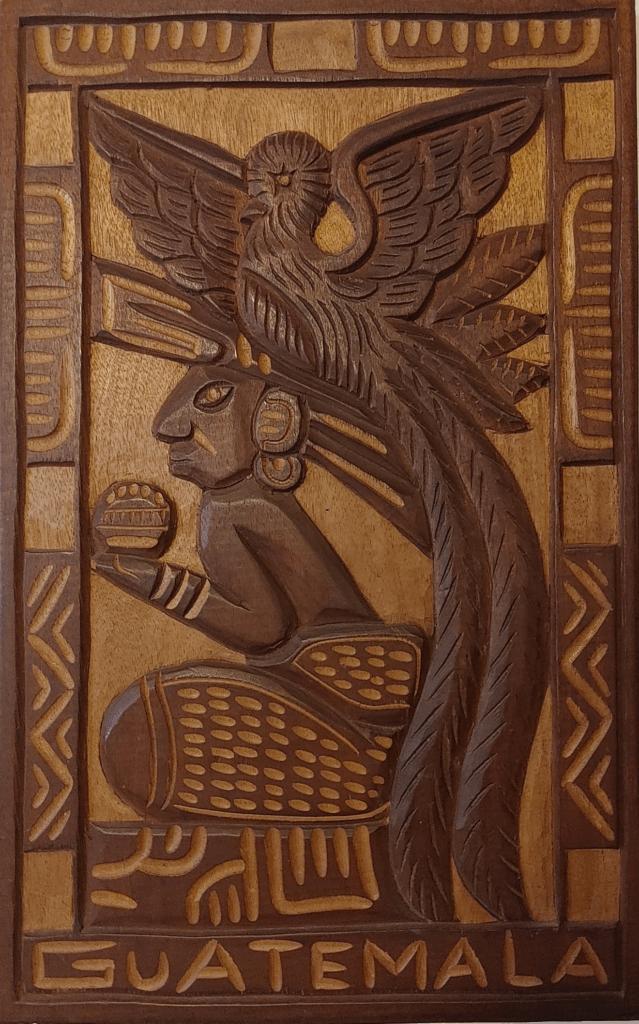
Figure 14. Wooden wall plaque purchased about 1990 from a local market in Guatemala that catered to tourists. (Photo by Wanless Southwick.)
Although my son didn’t associate the wall plaque with the Liahona, I did. The Quetzal bird, which rests upon the head of a man, could represent divine influence as the man seeks guidance and direction from a sacred ball (Liahona?), which he holds in his hands in front of him.
Whether the plaque represents a story from ancient Mesoamerican folk lore or is the creation of a modern native craftsman to depict a Book of Mormon scene, the true meaning of the wall plaque is unknown to us. Nonetheless, it reminds me of the Liahona.
[Wanless Southwick’s Note: When my son, John Southwick, saw me experimenting with vertical spindles in a crude Liahona model, he commented that one of the vertical spindles could have been stationary. His idea contributed to the final design of the model. Thanks also to my wife, Jerrie, who showed interest and loving patience during the long hours her husband was fully distracted by this project. Special thanks to Warren Aston for his encouragement and to Godfrey Ellis for his suggestions and editorial counsel.]


Wanless Southwick (PhD BYU) retired after careers in the US Army Medical Service Corps, environmental epidemiology, and education, all of which included research and study. He served as president of the Intermountain Society of Inventors and Designers in the 1970s. Among books he authored are Arabia’s Mountain of God where Moses, Elijah, and Lehi met with God (2024) and The Reason for Everything in the Grand Framework of Existence (2017). He and his wife, Jerrie, are the parents of eight children, and have thirty-five grandchildren and twenty-three great grandchildren at last count.

Kyle Kinghorn (MS BYU) holds degrees in Chemical and Manufacturing Engineering and currently teaches at BYU-Idaho in the department of Engineering Technology. Courses that he teaches include plastics, composites, tool design, prototyping, and CNC programming. He is also the president of Citius Composites, LLC, a company that specializes in the design and creation of products made from carbon fiber and other advanced materials. He has a passion for creating new products and the processes needed to make them. He and his wife, Malia, are the parents of three children.
10 Comment(s)
Jerry Grover, PE, 08-12-2025 at 8:50 pm
At some point you indicate that Don Bradley did not give any reasoning as to why the Liahona stopped working when the interpreters were located. It is not Don Bradley that came up with that, it was Joseph Smith, Sr where he is indicated to represent “The gold ball stopped here and ceased to direct them any further” in his Lapham interview. Plus given the fact that the interpreters were also referred to as “directors” in the Book of Mormon, is indicative that they could do the same function (and much more) than the Liahona. Also, I am not sure why you list the 1828 definition of compass for shape, etc. as this type of compass was not invented until much later than Lehi, so when Nephi called it a compass, it does not imply that it had to look or operate anything like the 1828 definition of compass. The word compass in the Old Testament in the KJV Bible refers to a “rim” or “ledge”. Also, the footnote to Gladden Bishop being a fool, is actually evidence in favor of Bradley’s proposal based on Bishop because Bishop, as a fool, would not be able to come up with an idea that actually might work.
While your proposal is interesting, unfortunately your proposed design only has one spindle which is not indicated by the text and is a primary reason that your approach has not been seriously considered. While you have arbitrarily labelled the middle axle a spindle, the definition of a spindle is a pointed rod, so the axle is not a spindle. The text does not indicate that there was a spindle and an axle, or that there are two different kinds of spindles. Spindles are mentioned in the Bible, as are axles so both terms were known to Nephi and he undoubtedly knew the difference. I’m kind of surprised that this issue was not brought up by someone who peer reviewed your article.
Replies
Wanless Southwick, 08-16-2025 at 11:13 pm
Jerry, apparently you, like Don Bradley, accept the veracity of Fayette Lapham’s memory of an interview that he had with Joseph Smith Sr. around 1830. Lapham’s memory of that experience was recorded about 40 years later, when he was 75 years old. By contrast, I share Loren Spendlove’s skepticism who said, “Lapham’s account reflects such grave confusion and errors as to render his story of little use for serious scholarship.”
Your claim that “the interpreters were also referred to as ‘directors’ in the Book of Mormon” cannot be verified. In fact, the idea that “the Liahona stopped working when the interpreters were located” was not specifically claimed by Joseph Smith Sr. or Lapham, but rather deduced by Bradley from the sequence of events recorded from Lapham’s memory. None-the-less, Bradley’s speculation, that “the interpreters [the Urim and Thummim]—presented as a superior instrument . . . the inferior Liahona was no longer needed and was, for the lack of better term, retired by God,” is an intriguing concept which aligns with events recorded in the Book of Mormon.
We agree with you that “when Nephi called [the Liahona] a compass, it does not imply that it had to look or operate anything like the 1828 definition of compass.” That’s why we used Noah Webster’s 1828 American Dictionary of the English Language to show the difference between a magnetic compass in Joseph Smith’s time (a round flat box with a single pointer needle inside), and the Liahona which Nephi said was ball-shaped with two “spindles” inside. Nephi’s language and his original writings were not in English, so the translation challenge was to express Nephi’s thoughts in English words that could be understood by Americans in 1829. Webster’s 1828 definition of “compass” and “spindles” help us interpret what the English version of Nephi’s writings meant.
The spindle was an essential fabric-making tool during Nephi’s time. In fact, every thread in Lehi’s family tent would have been spun from goat and/or camel hair by someone who used just their hands and a spindle to twist fibers into yarn and to wind the yarn around the spindle before weaving it into fabric. The drop-spindle was commonly used by ancient people because it had a disk-like flywheel (the whorl) firmly attached to the vertical shaft, which helped control the speed of rotation about the axis of the tool for consistent twisting of fibers into yarn (see our figure 5). Nephi undoubtedly could recognize a spindle when he saw one, so when the description he made of the internal workings of the Liahona was translated as spindles in English, we can reasonably assume that what Nephi saw reminded him of spindles used for spinning fiber into thread. That’s why the spindle inside our model of the Liahona looks like a drop spindle with a wide whorl.
You claimed that our model of the Liahona only has one spindle (the pointer spindle). You said, “the definition of a spindle is a pointed rod, so the axle is not a spindle.” You ignore the fact that our second spindle, which we call the “axle spindle,” matches Webster’s definition for “spindle” as being “the pin used in spinning wheels for twisting the thread, and on which the thread when twisted, is wound.” Our “axle spindle” with its wide whorl is very much like the drop spindle used in Nephi’s day for spinning fiber into yarn for clothing and tent fabric, and was still used in Joseph Smith time for that same purpose, despite the invention of more efficient tools such as the spinning wheel.
Our proposed model for the Liahona uses the drop-spindle design for the axle spindle and a vertical, pointer spindle on the edge of the whorl. Both spindles work together like gun sights to point the way that Lehi’s extended family should travel through the wilderness.
Replies
Jerry Grover, 08-19-2025 at 4:40 pm
Honestly it is kind of hard to make sense of your response tbh. As I stated in my reply, Don Bradley did NOT make up the Liahona not being used anymore once the interpreters were found. It is right out of the Lapham recounting (pgs. 308-9 HISTORICAL MAGAZINE, May 1870): “They also found something of which they did not know the use, but when they went into the tabernacle, a voice said, “What have you got in your hand, there?” They replied that they did not know, but had come to inquire; when the voice said, “Put it on your face, and put your face in a skin, and you will see what it is.” They did so, and could see everything of the past, present, and future; and it was the same spectacles that Joseph found with the gold plates. The gold ball stopped here and ceased to direct them any further”.
As far as his personal choice to completely ignoring the Fayette Lapham article, Spendlove obviously has his own opinion, but most LDS historians consider it a valuable source of information. Of course, like any historical source, it must be looked at in context, but there is a lot of actual information (most of it tbh) that is substantially correct (sometimes a bit out of order), so it is pretty clear it was written from notes taken during the interview. But you obviously are entitled to your opinion as well.
I am also not understanding where you assert that the word “directors” was not used for the interpreters in the Book of Mormon. The Original Text of the Book of Mormon in Alma 37:24 uses the term. While we don’t have the Original Text, Alma 37:21 refers to them as “directors” in the Printers Manuscript all the way up to the 1920 LDS Edition of the Book of Mormon. You might want to consult Royal Skousen’s Original Text project books (Part 4) if you don’t believe me.
As far as the 1828 Webster’s dictionary, the point is that Nephi was not using the 1828 dictionary (and neither was the divine translator) he was using Biblical Hebrew.
פֶּ֫לֶךְ (pelek): This is the common term for spindle in the Bible.
כִּישׁוֹר (kishor): This word specifically refers to the spindle’s shaft, the part that is twirled to spin the fibers.
As you can see, in Biblical Hebrew, the shaft has a different name than the spindle. Unless I misunderstand the function and engineering design (I don’t have a true set of mechanical cross-sections to evaluate) your proposal doesn’t have two spindles as Nephi would have understood them in Biblical Hebrew.
Wanless Southwick, 08-20-2025 at 3:06 pm
Jerry, Thanks for clarifying your thoughts and for the citation of Royal Skousen’s “Analysis of Textual Variants of the Book of Mormon” Part 4, which shows that Alma 37 verses 21 and 24, originally used the word “directors” (plural) to mean Urim and Thummim, instead of the less ambiguous word “interpreters,” which is used in today’s editions of the Book of Mormon.
The principle point of our proposed model of the Liahona is that the two spindles were vertical inside a hollow sphere and worked like gun sights to point the direction for Lehi’s travel in the wilderness. As Alma said, “…God could cause that those spindles should point the way they should go,” (Alma 37:40). Of the two spindles, Nephi said “one pointed the way whither we should go into the wilderness” (1 Nephi 16:10). Both that pointer spindle and the second spindle would have been attached vertically to a rotating disk. We chose to place the second of the two spindles at the axis of the disk, instead of at the opposite side of the disk. Either placement of the second spindle would work, but the axis location has the dual-purpose benefit of providing the axle for rotation and reducing the chance of confusing it with the pointer spindle.
Jack Lyon, 08-05-2025 at 2:28 pm
I’d like to point out that even using a regular compass requires faith that the needle is actually pointing north. If you don’t believe that’s the case, you won’t “progress in your journey.” Also, we moderns are quite familiar with how a magnetic compass works, but to ancient people, it must have seemed strange and miraculous. No matter which way you turn, the needle points in the same direction.
Replies
Wanless Southwick, 08-07-2025 at 9:19 am
In this paper we assert that the Liahona had no magnetic compass needle. We suggest it simply used two vertical spindles, similar to gunsights, to point at the direction for travel.
A magnetic compass is self-operating. Its magnetic needle always aligns with the magnetic field surrounding it and because Earth has a magnetic field, the compass needle aligns with it and points approximately at the north pole. Yes, using a magnetic compass requires faith that the needle is actually pointing north, but that faith is believing in the self-operating laws of physics (even if you know nothing about the physics involved).
We quoted Hugh Nibley, who said the Liahona “worked only by the power of God and only for appointed persons who had faith in that power.” Alma explained that if its authorized users “had faith to believe that God could cause that those spindles should point the way they should go, behold, it was done” (Alma 37:40).
So, the Liahona required faith BEFORE the pointers would work. By contrast, a magnetic compass works whether you have faith in it or not. You only need faith AFTER observing the direction pointed by the magnetic needle, that it is actually pointing north.
A magnetic compass needle keeps pointing north no matter which way you turn the compass housing. Similarly, the spindles inside the functioning Liahona kept pointing whichever direction God wanted Lehi to travel, allowing Lehi to turn himself and the Liahona’s viewing ports to see where the gunsight-like spindles pointed.
A magnetic compass only gives you the reference direction of north which you must use to calibrate your direction of travel. By contrast, the Liahona spindles simply “pointed the way whither we should go into the wilderness” (1 Nephi 16:10).
Loren Spendlove, 08-02-2025 at 9:51 pm
Wanless and Kyle, I really enjoyed your article and the novel approach that you have offered for consideration.
In Figure 12 you show the Liahona with your proposed design and a Hebrew inscription on its surface and on the inside of the ball. I applaud the effort to show the Hebrew writing, but the alphabet is all wrong, and especially the vowel points. The alphabet that you show in your exhibit was only adopted for use by Hebrew writers post-Babylonian captivity. Aramaic was written with this alphabet, but not Hebrew during Lehi’s time. So, Figure 12 in your article is anachronistic. And especially with regard to the vowel points (the small dots above and below some of the letters). These vowel points were developed by the Masoretes about 1,500 years after the time of Lehi. They did not exist, even with the borrowed alphabet from Aramaic, prior to about 800 CE.
The alphabet that Lehi and Nephi would have used is significantly different than that used today. For example, the Paleo-Hebrew, as it is often called, aleph, the first letter of the alphabet, looked like this: . In contrast, the Aramaic-influenced aleph, also used in modern Hebrew, looks like this: א. Likewise, the last letter of the alphabet, tav, looked like this in Paleo-Hebrew: x, and like this in modern Hebrew: ת. As you can see they are very different. So, I know it would be a lot of work, but you may want to redo Figure 12 to reflect the correct alphabet, and especially to remove the vowel points.
Replies
Wanless Southwick, 08-04-2025 at 11:54 am
You are right, Loren. The Hebrew alphabet used in our Figure 12 is anachronistic. As we said in the article, “we used modern Hebrew to simulate writing that Lehi and his extended family may have seen on the Liahona (1 Nephi 16:27).” We wanted to show where writing may have appeared on the Liahona, but we had two problems:
(1) The Book of Mormon does not tell us what words were written on the surfaces of the Liahona, so we chose to use two related scriptural verses from the Book of Mormon
a. 1 Nephi 16:29 “And thus we see that by small means the Lord can bring about great things.”
b. 1 Nephi 17:13 “. . . wherefore, inasmuch as ye shall keep my commandments ye shall be led towards the promised land; and ye shall know that it is by me that ye are led.”
(2) We don’t know what language or alphabet God may have used to write His messages on the surfaces of the Liahona for Lehi and his family to read. It may have been “Paleo-Hebrew” as you suggest. We considered simply using English but thought it would look more authentic if it were Hebrew. We wanted the words to be readable by modern people who know the Hebrew language, but since the Church does not publish a Hebrew translation of the Book of Mormon, we had to look elsewhere to get those verses in Hebrew. We found Tom Irvine’s “Book of Mormon, Hebrew & English,” archive.org/details/the-book-of-mormon-hebrew-english/page/174/mode/1up for one verse and used Google Translate for the other. The modern Hebrew alphabet they used included the vowel points that you object to. Yes, Figure 12 is anachronistic because it uses a modern Hebrew alphabet with vowel points, but that was by design.
And thank you, Loren, for your research article entitled “And the One Pointed the Way: Issues of Interpretation and Translation Involving the Liahona.” It had a significant influence on the development of our ideas for this article.
Raymond Takashi Swenson, 08-01-2025 at 10:48 pm
This is certainly an interesting proposal.
A good quality pathfinder compass has a round housing marked with compass directions and degree markings, containing the magnetic needle that points toward magnetic north, but the housing is mounted on a clear, transparent plastic rectangular base with a fixed arrow pointing from the base of the housing to one end of the base. The combination compass is set down on a map with the base arrow pointed in the intended direction of travel, and the housing rotated to match North to the magnetic north line marked on the map. At more northern latitudes, the magnetic force lines are skewed to the east or west depending on where the mapped area sits relative to the magnetic north pole. In the middle latitudes around Arabia, there is very little skewing of the magnetic north line from the geographic north line.
Once the travel direction arrow is set using the map, and the circular housing is rotated to match the local magnetic north line, you raise the compass off the map and rotate the entire assembly until the magnetic needle matches the North point on the circumference of the circular housing. The large arrow on the base then points in the direction of travel, and you look toward the horizon to mark two landmarks, one nearer and the other more distant, that you keep lined up while you walk across the terrain. When you arrive at the near landmark, which has been marked on the map, you repeat the process.
My personal view is that the simplest way to envision the “two needles” in the Liahona is to match the “two arrows” in a modern pathfinder compass, one pointing to magnetic north, the other pointing to the inspired direction of travel. The magnetic needle keeps you (literally) “Oriented” to the landscape, helping you identify where you are within the landscape you are crossing, and thus giving Nephi the directions parallel to the Red Sea, and eastward from Nahom to Bountiful.
The original meaning of the word “compass” in English was a pair of needles joined with a hinge near their connection point. The angle between the needles could be adjusted to set the radius of a circle to be drawn. One point would be inserted into the center of the circle, while the other would be drawn around that center to form a circle on a map. In the famous drawing by William Blake showing God reaching down to create the earth, he is spanning the disk of the earth with such an open drawing compass. The land was “compassed about” with the seas. The circle representing the earth would be marked with the cardinal directions, North, South, East and West, and intermediate directions NNE, etc., and a magnetic needle placed on a spindle at the center and able to spin freely. With a map and a scale matching inches on the map to miles on the land, a two pointer compass could span a distance, and the pointers then compared to a distance key on the side of the map, allowing you to estimate the distance traveled.
Just as the Interpreters/Urim & Thummim and seer stones displayed writing, it appears that the surface of the Liahona sphere and the two needles were able to display some limited writing. Perhaps the direction pointer showed a term like “Food” or “Journey”, that would tell the user what the arrow was pointing TO. Hunting down an antelope would be a different question than where you go after your tent is taken down and loaded on your pack animals.
Nevertheless, I wonder if one of the ways that the Liahona showed “writing” was simply by having the letters of the Hebrew alphabet, which also were used for numbers, arrayed around the rim of the compass, and letters pointed to one at a time by the direction pointer. In the same way that the astronaut stranded on Mars in the movie “The Martian” spells out words by pointing a camera at successive letters written on signs that are arrayed around a circle, and transmitting the series of images to earth with a robot’s camera, long sentences could be spelled out by a moving arrow pointing at letters, with motions among the letters to show when words or sentences begin or end. It was not until the era when movable type printing was invented that breaks between words and punctuation were added to written text in English and its ancestors. The pointer could spin two circles first, then stop at letters in turn, repeating the message several times. Like a modern Ouija Board, seeing the words spelled out repeatedly would be pretty miraculous to Lehi and his family.
As to the spherical ball enclosing the magnetic and directional arrows, I have wondered whether the sphere displayed a map of the world, with their path of travel inscribed across Arabia and the Indian and Pacific Oceans, reassuring Lehi’s party that they had a definite destination in mind, and there were places en route where they could stop and replenish their food.
Replies
Wanless Southwick, 08-04-2025 at 9:26 am
Your comments fit with similar ideas that are discussed in the section of this paper called “Speculation about the Design of the Liahona.” You describe how a modern magnetic compass can be used with a map for direction finding. Many of us learned to do that in our military training and in the Boy Scouts for orienteering. However, as far as we know, Lehi did not have a map or a magnetic compass.
Like others, you suggest that one of the Liahona’s spindles was magnetic and pointed north while the other spindle pointed at the inspired direction for travel. However, as we quoted from Spendlove’s research, Alma said both spindles were needed to “point the way” (Alma 37:40) and “the two pointers, or spindles, of the Liahona were not designed to function independently.” The claim that the Liahona had both “magnetic and directional arrows” lacks scriptural support.
Your suggestion that the Liahona “showed ‘writing’” by having an arrow point at letters of the Hebrew alphabet one at a time, like a modern Ouija Board, seems to be at odds with Nephi’s simple comment that writing on the surfaces of the Liahona was “plain to be read” (1 Nephi 16:29).
This paper uses both scriptural accounts and eyewitness descriptions to conclude that the ball-shaped Liahona likely had two vertical spindles inside, which under divine influence worked together like gunsights to point the way for Lehi’s travel.
Thanks for sharing your thoughts.